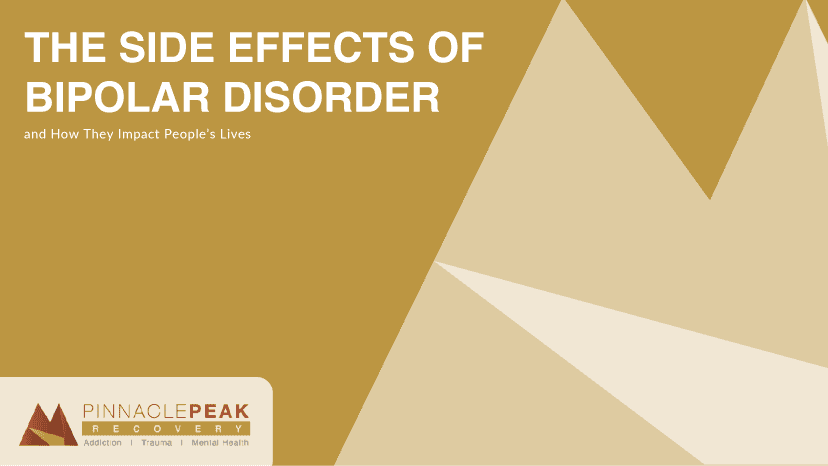“At times, [having bipolar disorder] can be an all-consuming challenge, requiring a lot of stamina and even more courage, so if you’re living with this illness and functioning at all, it’s something to be proud of, not ashamed of.”
- Carrie Fisher
Nearly 260,000 adults in Arizona have a serious mental illness. Many mental health conditions like bipolar disorder are severely misunderstood and sometimes stigmatized as a result. Our team here at Pinnacle Peak Recovery aims to help educate our community and overcome stigma so more people can get access to the care they need and deserve.
Today we’re going to talk about the side effects of bipolar disorder, and we’ll shine a light on how this condition can manifest and impact people’s lives.
What Is Bipolar Disorder and How Does It Affect People?
Bipolar disorder is a mental health condition that primarily impacts a person’s mood. It has four different forms: bipolar I, bipolar II, cyclothymic, and unspecified. Each of these forms comes with a certain combination of side effects ranging from manic to depressive. They occur at different severities and frequencies and can lead to hospitalization and other forms of disruption in a person’s day-to-day life.
Those who live with bipolar disorder are affected in a variety of ways. Some feel uncertain of what their “real self” is due to the drastic swing in experiences between their manic episodes, depressive episodes, and periods where they’re not in an episode. Others experience judgment from those around them who misunderstand their condition. Bipolar disorder can disrupt friendships and relationships or lead to financial strain.
So, what are the side effects of bipolar disorder that lead to these outcomes?
Recognizing the Most Common Side Effects of Bipolar Disorder
The side effects of bipolar disorder can be broken down into two categories: manic and depressive. We will explore how these two categories differ in a moment, but first let’s talk about how these symptoms most often present.
Most people with bipolar disorder will experience periods of symptoms, as opposed to symptoms that persist near daily like those living with conditions such as PTSD or generalized anxiety disorder. These periods can vary in length and severity, with more intense periods being known as “episodes.”
Depending on the severity of symptoms, it’s not uncommon for bipolar disorder to go unnoticed for a period, or to be misdiagnosed. Many people who have bipolar II, for example, may be first diagnosed with a depressive disorder before they’re diagnosed with bipolar disorder. On the other hand, some symptoms can be intense and lead to hospitalization. These moments should not be overlooked, especially if bipolar disorder has not been diagnosed yet.
To spot these symptoms for what they are, tracking can play an important role. Note how long these “moods” last and how regularly they occur. While there isn’t an exact timeline for symptoms that applies to everyone, most often the manic symptoms last about a week, and depressive symptoms last 2 weeks or longer.

Manic and Depressive Episodes: What’s the Difference?
While there is some overlap between manic and depressive episodes, they’re primarily opposites of each other. Their main similarities include that they can last for a week or more and can lead to hospitalization, but the experience of both is very different.
It’s important to note that someone with bipolar can experience manic and depressive symptoms without having a full episode. An episode is defined by its severity and length of time that the symptoms occur. To classify as an episode, a person must experience symptoms for most of the day, multiple days in a row.
Manic episodes consist of any combination of the following:
- Feeling very elevated or “high” for most of the day
- Feeling like you have excess energy, which can include jumpiness
- Being more prone to irritability
- Feeling a decreased need for sleep
- Having an increased appetite for food
- Having racing thoughts and rapid speech
- Feeling an increased urge to participate in pleasurable activities like drinking or sex
- Feeling an inflated sense of power or ego
Depressive episodes, on the other hand, consist of:
- Feeling increased worry and anxiety
- Feeling very slowed down or disconnected from the world around you
- Having trouble with sleep including lack of sleep or increased sleep
- Experiencing increased forgetfulness
- Feeling like you have nothing to say or talking slower than normal
- Lack of motivation to even do simple tasks
- Losing interest in activities, including ones you usually enjoy
- Increased feelings of hopelessness and worthlessness
- Increased chance of self-harm and suicidal ideation
People with bipolar disorder may also experience episodes that have any combination of the above symptoms, both depressive and manic. These episodes are known as “mixed episodes” and can vary in severity and length.
The Line Between Hypomanic and Mania
Those who have bipolar I will primarily experience manic episodes, whereas those with bipolar II or cyclothymic disorder may experience hypomanic symptoms. What’s the difference between these two?
Hypomanic symptoms are very similar to manic symptoms but with less severity. For example, someone experiencing hypomania may have heightened energy and talk faster, but not feel an inflated ego or participate in risky or irresponsible activities.
There isn’t a specific outline of hypomanic symptoms versus manic ones. They have much overlap and can vary from individual to individual. The primary difference between them is how powerful the symptoms are and how long they last.
How Often Does Someone With Bipolar Experience Side Effects?
As we mentioned earlier, someone with bipolar disorder rarely experiences symptoms year-round. While this timeline, as always, varies for each person, it also varies depending on their diagnosis.
People with bipolar I, when experiencing manic episodes, will experience symptoms for at least 7 days or more. When experiencing depressive episodes, symptoms last an average of two weeks.
Cyclothymic disorder, on the other hand, consists of hypomanic and depressive symptoms that occur throughout the year but are never intense enough to be classified as episodes. These symptoms often persist for half the year or more, with downtime between periods being two months or less.
Bipolar II isn’t defined by set timelines but consists of depressive episodes and hypomanic episodes.
If someone with bipolar disorder experiences four or more depressive or manic episodes in one year, this is known as “rapid cycling.”
The Best Ways to Manage Bipolar Symptoms From Home
While treatment is often integral to managing bipolar disorder, this doesn’t mean that there’s nothing you can do to help yourself. In fact, there are many ways you can continue your treatment right from home.
Not every approach will work for every person, but we’re going to talk about many of the most common ways you can set yourself up for success.
Keep track of your mood. Whether you use an app or a notebook, tracking your mood can help you better recognize when an episode or period of symptoms is occurring. Recognition of these moments can help you better react and manage your mood changes as they happen.
Try to identify things that may be triggering for you. This can include anything from yearly patterns like the change of seasons, or recognizing when you’re experiencing increased stress and knowing how this may impact your bipolar disorder. Knowing your triggers can help you avoid or prepare for them.
Find a good support system. Having people there for you who you can talk to about your treatment, emotional tracking, and more can lead to an easier time managing your symptoms. Support systems can help you stick with new routines, recognize behaviors you may not have noticed yourself, and even help you during your episodes. It’s important to make sure your support system is on board and is also taking care of themselves. Having backup plans in place for times when they might not be available to help you can take additional stress off both you and them.
Finally, don’t forget to be patient with yourself. Celebrate your successes, no matter how small. We all encounter rough patches. Even when it might feel like you’re making “negative progress,” know that the road isn’t the same for everyone and healing is never out of reach.
Alcohol-Withdrawal Only
- Depression
- Mood swings
- Headaches
- Fever
- Fatigue
- Seizures
Both Alcohol-Withdrawal & Anxiety
- Trouble thinking
- Nausea
- Rapid heart rate
- Irritability
- Increased sweating
- Shakiness

Treatment Options for Bipolar Disorder in Arizona
Finding a good bipolar treatment program can be key to helping you manage your symptoms and live your life the way you want to. There are many great programs right here in Arizona that understand your needs and want to see you thrive.
Bipolar treatment may vary from inpatient to outpatient, with ongoing support being important for not only your success but also for your mental health. There’s no reason for the weight of your healing to be placed entirely on you. There are many people who are finding healing alongside you, so don’t be afraid to use this support when it’s available.
If you want to get started with your healing journey, or if you’re looking for continued support for your bipolar treatment, Pinnacle Peak Recovery is here for you. With a wide range of evidence-based options available, there’s no time like the present to begin. Just give us a call anytime at 844-921-0635 and we’ll be happy to help.
Clinical Excellence | Compassionate Care | Family Feel

